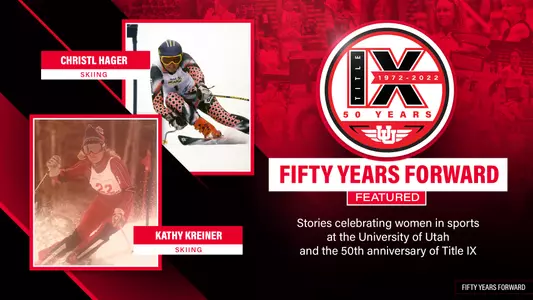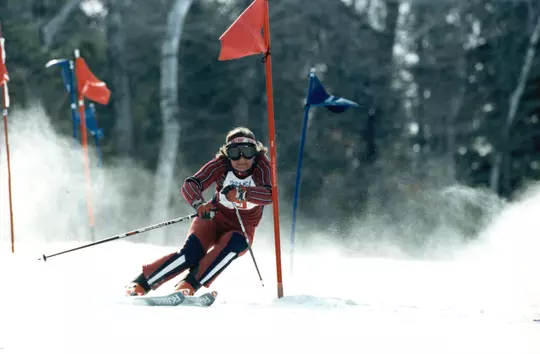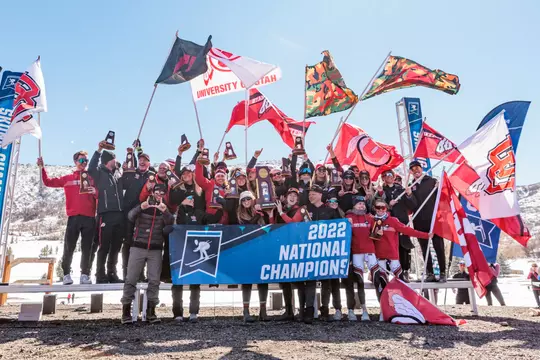Completed Event: General versus Arizona on January 18, 2002

General

9/6/2022 11:30 AM | General, Skiing
As Title IX led to the addition of women skiing at Utah 46 years ago, the coed program has gone on to win 15 national titles while bringing an international flavor to campus
Seventh In A Series
By Dirk Facer
University of Utah women’s athletics has some cool beginnings. One program, in fact, was so chill that it has called the snowy mountains home since its inception.
Women’s skiing officially came on board in 1976. Two years later, Utah won the Association for Intercollegiate Athletics for Women (AIAW) national championship.
In 1983, the NCAA began governing the sport and made it coed. Utah responded by winning five of the first six combined championships. Since then, the Utes have run their number of national crowns (including the AIAW victory and a men’s title in 1981) to 15 overall.
Current director of skiing, Fredrik Landstedt, has led Utah to a dominant stretch similar to its early years by capturing three of the four championships contested during his tenure, the last one coming this past March.
But looking back to those early years, it is quite clear Title IX played a pivotal role in the program’s development.
“I definitely think Utah was in the forefront there,” said Landstedt, who has been a collegiate ski coach since 1990. “Opening up the program and providing scholarships for women really helped. Utah was one of the schools that was able to do that right away.”

As such, he explained, there was immediate success when the NCAA combined men’s and women’s skiing. Utah supported skiing in a big way from day one of the current era, which gave the Utes a head start and has proven to be quite beneficial as the push for equality continued. At other institutions, sports like skiing have been cut as the financial resources for non-revenue sports have tighten in recent years.
“I think Title IX really saved skiing as an NCAA sport,” Landstedt said. “If it had been still only a men’s sport, I don’t think there would have been too many teams left in skiing. So the fact that we compete in men and women combined for the team score really saved skiing in the long term,” he added.
The unique situation for Landstedt, which includes overseeing both the men and women in the alpine and Nordic disciplines, does have some challenges. Even so, it’s something he thoroughly enjoys.
“It makes it a lot more fun, for sure, to have both the men and women out there training and competing together,” he said. “It’s obviously a little bit challenging to get the whole group to unite at times, but I think it’s a lot more fun getting this team to really become a cohesive group.”
And it is one, Landstedt continued, that has a lot of fun together.
I definitely think Utah was in the forefront there. Opening up the program and providing scholarships for women really helped. Utah was one of the schools that was able to do that right away.Fredrik Landstedt
Former senior associate A.D. and senior woman administrator Mary Bowman, who worked at Utah from 1996 until 2014, was the sport administrator for skiing. She was also the department’s first director of student-athlete support services, overseeing the Student-Athlete Advisory Committee (SAAC), the Life Skills program and the student-athlete wellness team.
During her time on the staff, Utah’s commitment to supporting student-athletes and funding its Olympic sports programs increased significantly. One of the driving forces behind that was Title IX.
“That’s why we were able to recruit so successfully from different parts of the Unites State and foreign countries,” Bowman said. “It didn’t matter as far as male or female sports. We were equally committed to both.”
Despite all of the progress that’s been made, though, Title IX is still spreading its wings.
“It has come a long ways but there’s still a long ways to go — especially trying to get more women’s coaches,” said Bowman, who was also a high school girls’ volleyball and basketball coach for 20 years. “I think that’s really important in women’s athletics. But it’s hard to get that equality.”
In addition to increased operating budgets for sports, building world-class training facilities has been a large part of Utah’s formula for success. The Spence Eccles Ski Team Building backs such intentions. The state-of-the-art facility opened on campus in 2017. It’s the first of its kind venue for alpine and Nordic competitors featuring locker rooms, film study, a lounge and other amenities such as a meeting room, tuning operations and storage.

Utah has a lot to offer skiers and has drawn interest that crosses borders. Title IX brought international recruiting to the forefront. Landstedt noticed that as a student-athlete at New Mexico in the late 1980s there were numerous Scandinavians coming to the United States to go to college and ski.
“They don’t have that system over there in Europe where you can be a full-time student and then be a top-level athlete,” Landstedt said. “So the U.S. is really the place where you can do it. (Title IX) opened that opportunity for a lot of those women to get a chance to come over here and get a great education and compete in skiing.”
Utah’s skiing program has flourished since the university officially added the women’s program to go along with the men’s 46 years ago. The women alone have had well over 100 All-Americans and 35 individual national champions. The men’s and women’s programs have produced a combined 49 Olympians, including participants from the United States, Argentina, Australia, Austria, Canada, Estonia, Iceland, Lebanon, Norway and Slovakia.
Individual standouts — both collegiately and internationally —are abundant. Among the top performers are multiple national college champions Toril Forland, Bente Dahlum, Christl Hager, Anke Friedrich, Maria Graefnings, Sydney Palmer-Leger, Heidi Selnes and Katrin Smigun.
Alpine skiers Hillary Forest and Lyndall Heyer were All-Americans on the 1978 AIAW national championship team.
I would not have been able to ski race and continue at a collegiate level without the help of a scholarship. I can’t imagine where I would be today if that opportunity never came my way.Christl Hager
Hager, who won three NCAA individual titles during her career with the Utes from 1994-97, had aspirations of making the U.S. Olympic Team before a series of knee surgeries got in her way. Once that dream was gone, the California native was forced to go another direction.
“I would not have been able to ski race and continue at a collegiate level without the help of a scholarship,” Hager said. “I can’t imagine where I would be today if that opportunity never came my way. Not just the value that relates to my education, but the opportunity of being able to both compete and study in a great environment that one can strive to be the best in both.”
Hager, like so many other elite skiers who elected to continue their career at the U rather than competing individually, cherished her collegiate experience.
“Getting in the ski team van with your teammates, either going to training up in the mountains or off to ski race, you can feel the excitement, joy, and the energy of the team. The feeling of belonging and having a joint goal is so special.”
Not much has changed at Utah over the years. A winning blueprint has kept the program competitive.
“It was a real variety of people,” Kreiner said of the squads she was on in the 1980s. “It was a multicultural team that came together for a common goal.
Still is.
